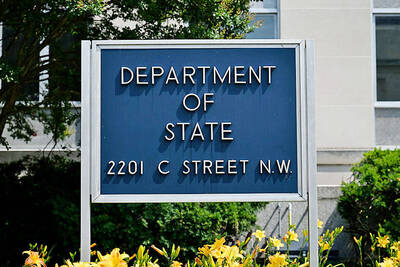Despite China’s repeated attempts to force Taiwan’s incoming administration to accept the idea that both sides of the Taiwan Strait belong to “one China,” a survey released yesterday showed that most people reject the construction.
The survey, conducted by Taiwan Indicators Survey Research (TISR) on Thursday and Friday last week, sought to gauge Taiwanese perception of the notion that “both sides of the Strait belong to one China,” which is backed by both the Taipei and Beijing constitutions.
Article 11 of the Additional Articles of the Republic of China (ROC) Constitution states: “Rights and obligations between the people of the Chinese mainland area and those of the free area [Taiwan], and the disposition of other related affairs may be specified by law.”
In the preface to the People’s Republic of China (PRC) Constitution, Taiwan is listed as part of the “sacred territory” of the PRC.
Asked about their opinions on the statement that “one China” refers to the PRC, an overwhelming majority, or 81.6 percent, of respondents opposed the concept, with only 9.2 percent accepting the notion.
Even if “one China” refers to the ROC, 60 percent of those polled still disliked the idea that both sides belong to “one China,” but the percentage of people willing to embrace the notion rose to 28.8 percent.
Respondents who identified themselves as pan-blue supporters appeared to be divided on the issue, as 54.3 percent of them welcomed the concept of both sides belonging to the ROC, but 39 percent found it insupportable, the poll showed.
A majority of pan-green respondents, or 81.8 percent, were negative toward the assertion, compared with 14.2 percent who thought otherwise, the survey showed.
The results showed that the degree of people’s dislike of the idea that both sides of the Strait belong to one China is inversely proportional to their age, regardless of whether “one China” refers to the PRC or the ROC.
Of those polled, 75.8 percent equated abiding by the ROC Constitution to maintenance of the cross-strait “status quo,” while 14.1 percent disagreed.
Public consensus still seems to be lacking with regard to China’s repeated insistence on setting president-elect Tsai Ing-wen’s (蔡英文) acceptance of the so-called “1992 consensus” and the notion of both sides belonging to “one China” as a precondition for continued cross-strait government and economic exchanges.
About 38 percent of respondents believed Tsai should not acknowledge the “1992 consensus” under such a condition, while 33.4 percent urged the incoming president to do so, the poll showed. Nearly 29 percent declined to express their opinions.
In addition to political affiliation, age also appears to be a key factor in debates on the issue.
Respondents aged between 20 and 39 tended to aspire to see Tsai shrug off the “1992 consensus,” while those in the 40 to 59 age group generally believed she should welcome the consensus, the survey indicated.
The “1992 consensus” refers to a tacit understanding between the Chinese Nationalist Party (KMT) and the Chinese Communist Party (CCP) that both sides of the Taiwan Strait acknowledge there is “one China,” with each side having its own interpretation of what “China” means.
Former Mainland Affairs Council Chairman Su Chi (蘇起) has admitted that he made up the term in 2000.
The telephone-based poll collected 1,000 valid samples from Taiwanese aged 20 or older.
In related news, the Chinese-language United Daily News yesterday published a survey it conducted to gauge ideas of national identity, in which a record high of 73 percent of people identified themselves as Taiwanese.
“Over the past two decades, the percentage of people who identified themselves as Taiwanese has climbed from 44 percent in 1996 to 55 percent in 2006, then to a record-high 73 percent in our latest poll,” the newspaper said.
The proportion of people identifying as Chinese hit a record-low of 11 percent, down from 20 percent in 2006 and 31 percent in 1996, the United Daily News poll suggested.

A car bomb killed a senior Russian general in southern Moscow yesterday morning, the latest high-profile army figure to be blown up in a blast that came just hours after Russian and Ukrainian delegates held separate talks in Miami on a plan to end the war. Kyiv has not commented on the incident, but Russian investigators said they were probing whether the blast was “linked” to “Ukrainian special forces.” The attack was similar to other assassinations of generals and pro-war figures that have either been claimed, or are widely believed to have been orchestrated, by Ukraine. Russian Lieutenant General Fanil Sarvarov, 56, head

SAFETY FIRST: Double the number of police were deployed at the Taipei Marathon, while other cities released plans to bolster public event safety Authorities across Taiwan have stepped up security measures ahead of Christmas and New Year events, following a knife and smoke bomb attack in Taipei on Friday that left four people dead and 11 injured. In a bid to prevent potential copycat incidents, police deployments have been expanded for large gatherings, transport hubs, and other crowded public spaces, according to official statements from police and city authorities. Taipei Mayor Chiang Wan-an (蔣萬安) said the city has “comprehensively raised security readiness” in crowded areas, increased police deployments with armed officers, and intensified patrols during weekends and nighttime hours. For large-scale events, security checkpoints and explosives

PUBLIC SAFETY: The premier said that security would be tightened in transport hubs, while President Lai commended the public for their bravery The government is to deploy more police, including rapid response units, in crowded public areas to ensure a swift response to any threats, President William Lai (賴清德) said yesterday after a knife attack killed three people and injured 11 in Taipei the previous day. Lai made the remarks following a briefing by the National Police Agency on the progress of the investigation, saying that the attack underscored the importance of cooperation in public security between the central and local governments. The attack unfolded in the early evening on Friday around Taipei Main Station’s M7 exit and later near the Taipei MRT’s Zhongshan

REBUFFED: In response to Chinese criticism over recent arms sales, Washington urged Beijing to engage in meaningful dialogue instead of threats and intimidation Washington’s long-term commitment to Taiwan would not change, the US Department of State said yesterday, urging Beijing to stop pressuring Taiwan and engage in meaningful bilateral dialogues. The remarks came in response to a backlash from Beijing about Washington’s latest approval of arms sales to Taiwan. The US Defense Security Cooperation Agency said in a statement on Wednesday that the Taipei Economic and Cultural Representative Office in the US has asked to purchase an arms package, including Tactical Mission Network Software; AH-1W helicopter spare and repair parts; M109A7 self-propelled howitzers; HIMARS long range precision strike systems; tube-launched, optically tracked, wire-guided missiles; Javelin